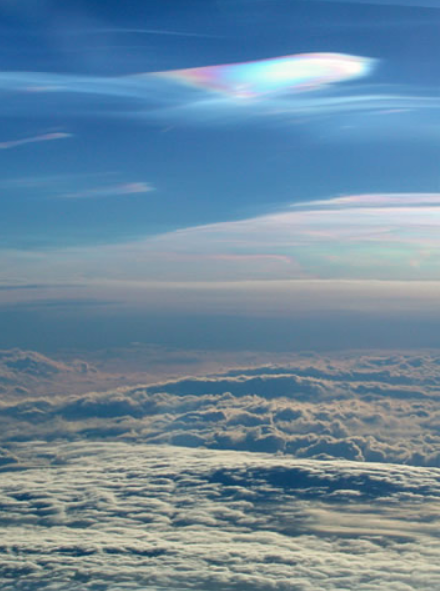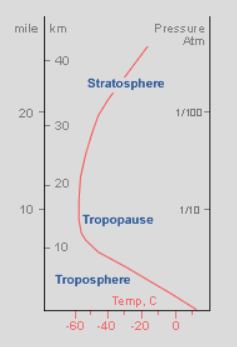Tropopause and lower stratosphere
Tropopause and Lower Stratosphere: Understanding the Boundary of the Earth's Atmosphere
The tropopause and lower stratosphere play crucial roles in shaping the Earth's atmosphere. As we ascend from the ground level, we experience a drop in air pressure, density, and temperature. This temperature variation is the key factor in determining the structure of the atmosphere. While the troposphere, the first few miles of the atmosphere, is primarily warmed by contact with the ground rather than solar radiation, convection is the main process responsible for mixing and heating this region.
Convection occurs when the surface-heated air expands, becomes less dense than the surrounding cooler air, and rises as buoyant and turbulent bubbles. However, an intriguing phenomenon arises as we ascend higher into the troposphere: the temperature begins to decrease. This temperature drop can be attributed to the expansion of isolated bubbles of air that are heated by the ground and rise upwards. As these bubbles climb, the pressure around them decreases, causing them to expand and cool. The internal molecular energy or heat content of these bubbles decreases, leading to a drop in temperature.
The rising bubbles of air will continue to ascend until their temperature matches that of the surrounding air. If we visualize the atmosphere as a collection of these bubbles, it becomes evident that they would rise and descend until a natural equilibrium state is reached, characterized by a smooth decrease in temperature with increasing height. This equilibrium state is known as the tropopause.
Located at approximately 12 kilometers above the Earth's surface, the tropopause acts as a barrier between the troposphere and stratosphere. It hinders mixing and heat transport by convection since convection can only occur when temperature decreases with height. Consequently, the troposphere, where convection is allowed, remains turbulent and well-mixed, while the stratosphere experiences an increase in temperature with height, making it stable, stratified into layers, and relatively poorly mixed.
In addition to its role as a boundary, the tropopause also exhibits fascinating temperature extremes. At high latitudes, the temperature in the tropopause and lower stratosphere can plummet to around -85°C, creating the ideal conditions for the formation of polar stratospheric clouds (PSCs). Within this subset of PSCs, we find the incredibly vibrant and colorful nacreous clouds.
The atmospheric temperature profile varies with latitude, with the height of the tropopause ranging from approximately 16 kilometers at the equator to only 8 kilometers at the poles. This variation is influenced by factors such as sea level temperature and season. Officially, the tropopause is considered to begin at the lowest level when the lapse rate (the rate of temperature decrease with increasing altitude) falls to 2°C per kilometer.
While the tropopause is often seen as a barrier between the troposphere and stratosphere, it is not an impermeable boundary. Tropospheric storms with strong convection can transport water vapor across the tropopause. Furthermore, breaks in the tropopause near jet stream westerlies allow for the interchange of stratospheric and tropospheric air.
Above the tropopause, mixing is facilitated by gravity waves, and at even higher altitudes, molecular diffusion becomes an important factor in atmospheric dynamics. These mechanisms ensure that despite the presence of a boundary, there is still some degree of interaction and exchange between the different layers of the atmosphere.
Understanding the tropopause and lower stratosphere provides valuable insights into the complex dynamics and composition of our atmosphere. By unraveling the intricacies of this boundary, scientists can gain a deeper understanding of how various atmospheric processes shape our weather patterns, climate, and overall environmental conditions.

View across the tropopause from a high flying research aircraft. Below are familiar tropospheric clouds, above are rare nacreous clouds formed at the low temperatures of the tropopause and lower stratosphere. Imaged by Paul Newman of NASA Goddard Space Flight Center. Image ©Paul Newman, shown with permission.
As we climb from ground level our ears pop and it gets colder. The air pressure, density and temperature fall. The atmosphere's temperature is the most important property controlling its structure.
The air in the first few miles of the atmosphere, the troposphere, does not significantly absorb solar radiation, instead it is warmed by contact with the ground. The surface heated air expands as it warms, becomes less dense than surrounding cooler air and rises as buoyant and turbulent bubbles. This is convection and is the main process by which the troposphere mixes and heats.
Although convection stirs and mixes the troposphere, the higher it is the colder it becomes. Why?

Imagine an isolated bubble of air heated by the ground and bobbing upwards. As it climbs the pressure falls and so the bubble expands to equalise its pressure with the air around it. To expand, the bubble must exert a force on the surrounding air and move it away. The work done requires energy and the only source is the internal molecular energy or heat content of the bubble's air. The internal energy decreases and the temperature, which is purely the measure of it, falls..
The bubble will rise until its temperature is the same as the surrounding air. If we visualize the atmosphere as made up entirely of such bubbles we see that they would rise and descend until a natural equilibrium state is reached where the temperature falls smoothly with increasing height...
If the air were never heated by solar radiation its temperature would continue to fall as we climb. However, at a height of ~12 km a minimum of ~-55°C is reached, the tropopause.... Above that the temperature starts to increase again because the stratospheric air contains a sunlight absorber, ozone.
The tropopause minimum acts as a barrier^ between the troposphere and stratosphere because mixing and heat transport by convection can only occur when temperature decreases with height. The troposphere - with convection allowed - is turbulent and well mixed. The stratosphere with its temperature increase with height is stable, stratified into layers and relatively poorly mixed^^.
At high latitudes the tropopause and lower stratosphere temperature can plunge to ~ -85°C to provide the conditions for PSCs, polar stratospheric clouds of which the incredibly bright and colourful nacreous clouds are a subset.
. Temperature is a measure of the molecular internal energy which derives from kinetic, rotational and vibration al motion. the more energetic the motion, the higher the temperature.
.. The rate of fall is known as the 'lapse rate. Its mean value is 6.5°C/km. Actual rates depend on temperature and humidity. High temperature humid air can have a rate of only 4°C/km.
... The atmospheric temperature profile is latitude dependent. The tropopause height varies from ~16 km at the equator to only ~8 km at the poles. It depends also on sea level temperature and season. Officially the tropopause starts at the lowest level when the lapse rate falls to 2°C/km.
^ The tropopause is not a complete barrier, it leaks. Strongly convective tropospheric storms transport water vapour up across the tropopause. There are breaks in the tropopause near jet stream westerlies allowing interchange of stratospheric and tropospheric air.
^^ Mixing above the tropopause is helped by gravity waves. Much higher still, molecular diffusion becomes important.
Note: this article has been automatically converted from the old site and may not appear as intended. You can find the original article here.
Reference Atmospheric Optics
If you use any of the definitions, information, or data presented on Atmospheric Optics, please copy the link or reference below to properly credit us as the reference source. Thank you!
-
<a href="https://atoptics.co.uk/blog/tropopause-and-lower-stratosphere/">Tropopause and lower stratosphere</a>
-
"Tropopause and lower stratosphere". Atmospheric Optics. Accessed on April 27, 2024. https://atoptics.co.uk/blog/tropopause-and-lower-stratosphere/.
-
"Tropopause and lower stratosphere". Atmospheric Optics, https://atoptics.co.uk/blog/tropopause-and-lower-stratosphere/. Accessed 27 April, 2024
-
Tropopause and lower stratosphere. Atmospheric Optics. Retrieved from https://atoptics.co.uk/blog/tropopause-and-lower-stratosphere/.